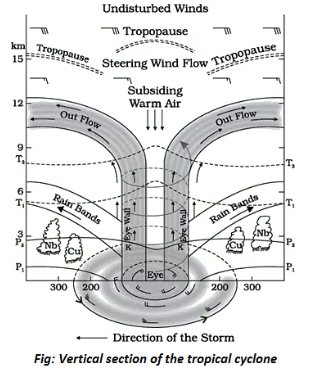16-09-2024 Mains Question Answer
Q. Explain the Origin of Tropical Cyclone and how it is different from temperate Cyclone
Approach:
Introduction: Give a brief definition of tropical cyclone.
Main body: First write about the optimal conditions required for the formation of tropical cyclone and the process of formation of tropical cyclones.
Then in second part write the differences between tropical and temperate cyclone
Conclusion: Conclude answer by summarising main body, either based on tropical cyclone or on the basis of comparison between tropical and temperate cyclone.
Introduction: Tropical cyclones are intense low-pressure areas between 30°N and 30°S, with high winds spanning 500-1,000 km horizontally and 12-14 km vertically, powered by latent heat from ocean moisture.
Optimal Conditions for formation of tropical cyclone:

- Warm Sea Surface Temperature: Requires Ocean water temperatures above 27°C for heat and moisture.
- Coriolis Force: Earth’s rotation causes the Coriolis effect, deflecting air to the right in the Northern Hemisphere and left in the Southern Hemisphere, enabling cyclonic rotation.
- Stable Vertical Wind Speed: Minimal vertical wind speed variations, typically under 10 m/s, support storm organization by maintaining the cyclone’s structure.
- Low-Pressure Area: A pre-existing low-pressure area, often below 1000 hPa (hectopascals), initiates cyclone formation.
- Higher Divergence Above Sea Level: Divergence at 12-14 km altitude enhances upward air movement and storm intensification by improving outflow and lowering surface pressure.
Developmental Stages
- Origin: Begins over tropical oceans from August to mid-November, with the Coriolis effect initiating rotation.
- Formation and Initial Development: Involves water vapor transport, convection, and the formation of cumulus clouds.
- Mature Stage: Intensifies with powerful thunderstorms, forming a warm “Eye” and organized spiral bands.
- Modification and Decay: Weakens when warm, moist air is cut off, with core low-pressure reduction and slower speeds, often due to landfall or cooler waters.
Difference between tropical and temperate cyclone:
| Basis of differences | Tropical Cyclone | Temperate Cyclone |
| Location | Forms in tropical regions (between 5° and 20° latitude). | Forms in temperate regions (mid-latitudes, 30° to 60° latitude). |
| Formation | Over warm ocean waters (typically above 27°C). | Forms along fronts were warm and cold air masses meet. |
| Energy Source | Derived from warm ocean water and latent heat release. | Driven by temperature gradients between air masses. |
| Pressure system | Characterized by a central low- pressure system with high-pressure surroundings. | Associated with a low-pressure system that moves along a front. |
| Structure | Well-defined eye, symmetrical structure, and organized convection. | Less organized, no central eye, and associated with frontal systems. |
| Size | Generally larger in scale, often exceeding 200-500 km in diameter. | Typically smaller, ranging from 100-1,000 km in diameter. |
| Wind speed | Typically stronger, with sustained winds exceeding 63 km/ h (gale force) and can reach over 250 km/h in intense cases. | Winds are generally less intense, usually ranging from 40-100 km/h. |
| Precipitation | Heavy rainfall, with intense thunderstorms and storm surges. | Moderate rainfall |
| Movement | Moves westward and poleward; follows trade winds. | Moves eastward and usually follows the mid-latitude westerlies. |
| Seasonality | Predominantly forms from late summer to early fall (June to November in the Northern Hemisphere). | Can occur year-round, with peak activity in winter and spring. |
| Lifecycle | Generally, has a longer lifespan, ranging from a few days to over a week. | Shorter lifespan, usually lasting from a few days to a week. |
| Dissipation | Weakens over land or cooler waters; requires warm waters to maintain strength. | Weakens as it moves away from the frontal zones or over land. |
| Example | Katrina, Idai (2019) | Winter storm Eunice (2022) |
Conclusion:
In sum, tropical and temperate cyclones differ in their origins, structure, and effects, shaped by their respective climatic and environmental conditions.

